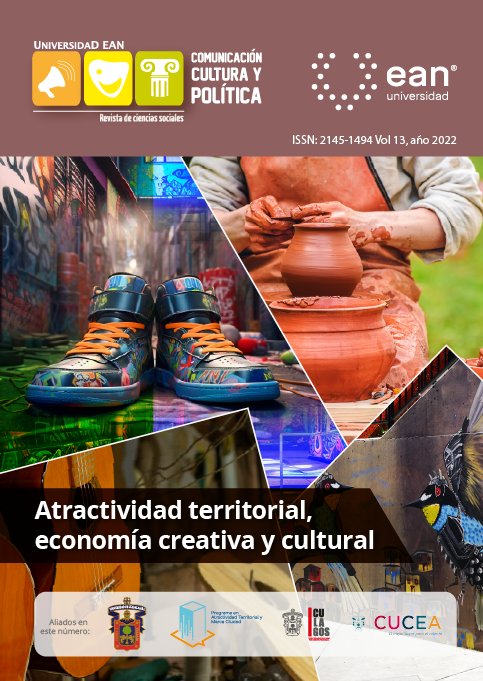National images, the international system, and territorial attractiveness
National images, the international system, and territorial attractiveness a study of endogenous and exogenous forces in the case of Mexico (2008-2018)
Contenido principal del artículo
Resumen
All nations possess various assets that create an image of national and cultural identity to the public abroad. This image can produce either attraction or repulsion, depending on a range of domestic and international factors. This paper aims to explore the endogenous and exogenous forces involved in the process of national image-making, which, in combination with the context of the international system, creates a specific sense of attractiveness for foreign audiences. The author uses data from the period between 2008-2018 related to Mexico to investigate and authenticate the force that has greater explanatory power in understanding the idea of territorial attractiveness embedded in soft power dynamics and public diplomacy.
Detalles del artículo
Referencias (VER)
Boulding, K. E. (1959). National images and international systems. The Journal of Conflict Resolution, 3(2), 120-131. https://doi.org/10.1177/002200275900300
Castells, M. (2012). Comunicación y poder. Siglo XXI.
Chen, M.; Bargh, J. A. (1997). Nonconscious behavioral confirmation processes: the self-fulfilling consequences of automatic stereotype activation. Journal of Experimental Social Psychology, (33), 541-560. https://doi.org/10.1006/jesp.1997.1329
Cull, N.J. (2009). Diplomacia pública: consideraciones teóricas. Revista Mexicana de Política Exterior, 1(86, Spring). https://revistadigital.sre.gob.mx/index.php/rmpe/article/view/690
Hobbes, T. (1987). Leviatán, o lo material, forma y poder de una república eclesiástica y civil. Fondo de Cultura Económica (FCE).
Hobsbawm, E.; Ranger, T. (1983). The invention of tradition. Cambridge University Press. Holsti, O. R. (1962). The belief system and national images: a case study. The Journal of Conflict Resolution, VII, 244-252. https://doi.org/10.1177/002200276200600306 Holsti, O. R. (1967). Cognitive dynamics and images of the enemy. Journal of International Affairs, 1(21), 16-39. Holsti, O. R. (2005). To see ourselves as others see us: how publics abroad view the United States in the post-9/11 era. Public Opinion Pros. Holsti, O. R. (2006). American public opinion and foreign policy: did the september 11 attacks change everything. In D. Forsythe.; P. McMahon.; A. Wedeman (Eds.), American Foreign Policy in a Globalized World (pp. 141-172). Routledge. Jackson, P. T. (2006). Relational constructivism: a war of words. In J. Sterling-Folker (Ed.), Making Sense of International relations Theory (pp. 152-168). Lynne ed.
Jervis, R. (1970). The logic of images in international relations. Princeton University Press.
Jervis, R. (1976). Perception and misperception in international politics. Princeton University Press.
Jervis, R. (1997). System effects. Princeton University Press.
Kunczik, M. (1977). Image of nations and international public relations. Lawrence Erlbaum Associates.
Lara, R. F. (2015). Determinantes de la marca-país de Brasil, México y Perú. En D. Borrajo.; V. Eneko.; C. Silva.; D. Cubilledo.; I. Perea.; C. Pulleiro (Coords.), América Latina y el Caribe, entre la encrucijada hemisférica y los nuevos retos globales (pp. 75-104). GEALC/LAKIT, Universidad del País Vasco.
Lara, R. F.; Campos, A.; Partida, P.; Sepúlveda, I. (2021). Atractividad urbana: teoría, técnica y práctica. ECOE Ediciones.
Larson, D. (1997). Trust and missed opportunities in international relations. Political Psychology, 3(18), 701- 743. https://www.jstor.org/stable/3792108
Martel, F. (2011). Cultura mainstream: cómo nacen los fenómenos de masas. Taurus.
Nye, J. (2004). Soft power: the means to success in world politics. Public Affairs.
RMPE (2017). Un poder suave para México. Secretaría de Relaciones Exteriores.
SECTUR. (2018). Undersecretariat of planning and tourism policy, results of tourism activity 2018. https://www.datatur.sectur.gob.mx/RAT/RAT-2018-12(EN).pdf
Tenorio, M. (1998). Artilugio de la nación moderna. México en las exposiciones universales, 1880-1930. Fondo de Cultura Económica.
Van Ham, P. (2001). The rise of the brand state, the postmodern politics of image and reputation. Foreign Affairs, 80(2-6). https://doi.org/10.2307/20050245
Vertzberger, Y. I. (1990). The world in their minds: information processing, cognition, and perception in foreign policy decisionmaking. Stanford University Press.
World Bank. (2022). Indicators for Mexico. https://data.worldbank.org/country/mexico
Wright, Q. (1955). International organization and peace. The Western Political Quarterly, (8)2, 149-165. https://doi.org/10.1177/106591295500800201
Descargas
Datos de publicación
Declaraciones de autoría
- Sociedad académica
- Universidad Ean
- Editorial
- Universidad Ean










